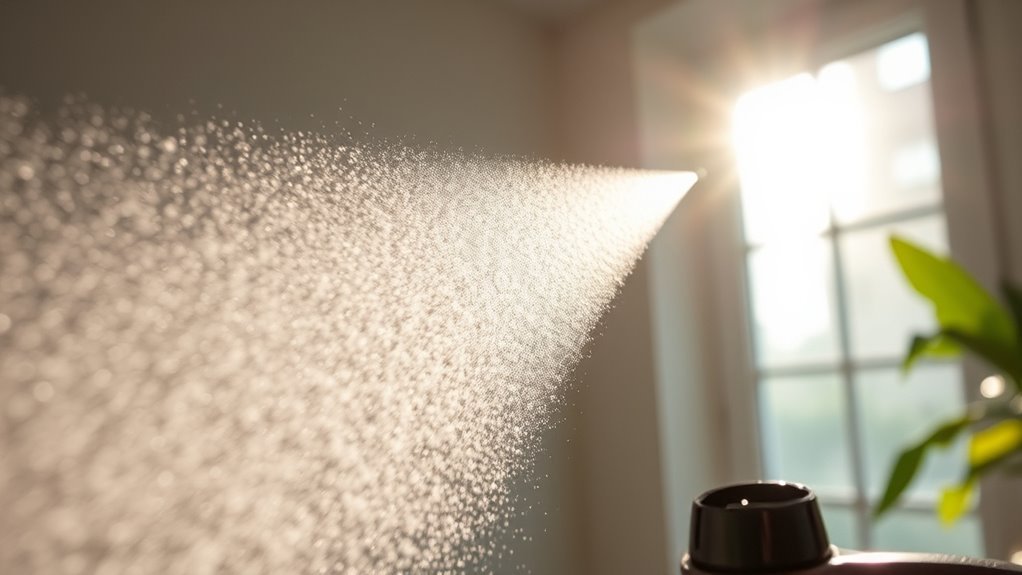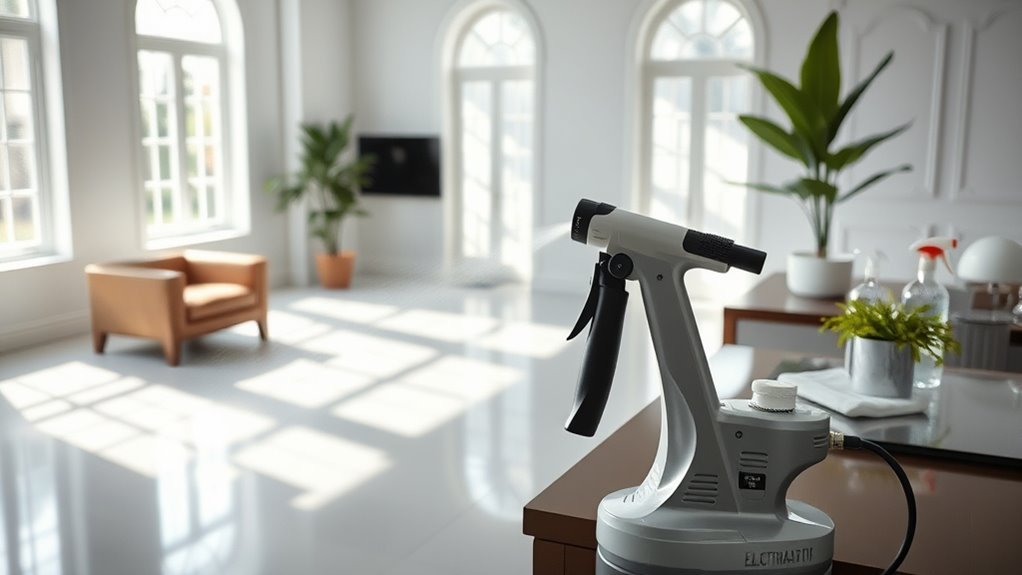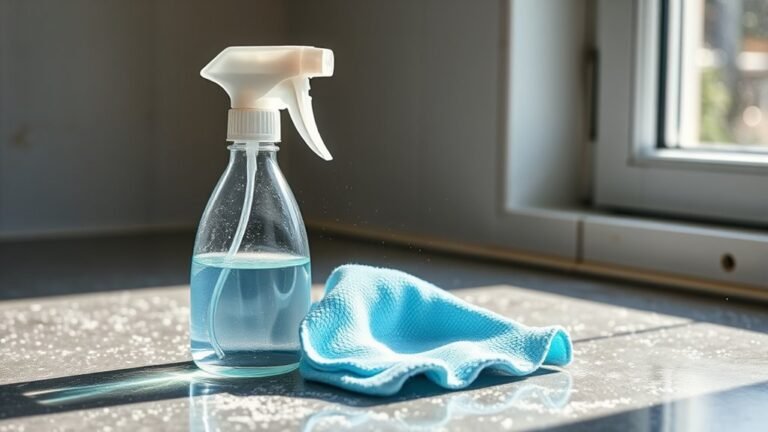Tipps zur Verwendung elektrostatischer Sprühgeräte zur Desinfektion
When using electrostatic sprayers, choose approved disinfectants with proper contact times and dilute as needed for safe, effective coverage. Clear and ventilate the area, wear protective gear, and hold the sprayer steadily to let charged droplets evenly wrap surfaces, including edges. Regularly maintain and clean your sprayer, check batteries, and troubleshoot nozzle clogs for consistent performance. Follow these tips to maximize disinfection while minimizing waste—and explore additional details to master the process fully.
Understanding How Electrostatic Sprayers Work

Although the technology behind electrostatic sprayers might seem complex, it’s actually quite straightforward once you understand the basics. When you use one, the sprayer imparts an electrostatic charge to the disinfectant droplets. This charge causes the droplets to be attracted to surfaces, allowing them to wrap around and cover areas evenly. You’re not just spraying disinfectant—you’re ensuring it clings effectively, enhancing sprayer efficiency. This means less product waste and better coverage, freeing you from constant reapplication. Understanding this helps you appreciate how electrostatic sprayers empower you to disinfect spaces thoroughly and efficiently. Once you grasp how the electrostatic charge works, you’ll see why this method is a game-changer for anyone looking to maintain clean, safe environments with ease and freedom.
Choosing the Right Disinfectant Solution
When selecting a disinfectant solution for your electrostatic sprayer, you’ll want to evaluate factors like effectiveness, safety, and compatibility with the equipment. Different disinfectant types vary in how well they work against viruses, bacteria, and fungi, so choosing one with proven solution efficacy is key. You also want a formula that won’t damage your sprayer or leave harmful residues.
Keep these points in mind:
- Confirm the disinfectant is approved for electrostatic application
- Check contact time to guarantee quick and thorough disinfection
- Opt for solutions that are non-corrosive and safe for surfaces
- Consider environmental impact and user-friendly ingredients
Picking the right disinfectant lets you spray confidently, protecting spaces without limits.
Preparing the Area for Spraying

Before you start spraying, make certain to clear surfaces and remove any clutter to allow even coverage. You’ll also want to guarantee proper ventilation to keep the air fresh and safe. Don’t forget to take out sensitive items that could be damaged by the disinfectant.
Clear Surfaces and Clutter
Since electrostatic sprayers rely on evenly coating surfaces, you’ll want to clear away any clutter and debris that could block the spray. Proper surface preparation is key to revealing the freedom of effective disinfection. Use these decluttering tips to get your space ready quickly:
- Remove personal items, papers, and electronics from countertops and desks
- Clear chairs and seating areas to expose all surfaces
- Pick up trash and sweep visible dirt or dust
- Move small furniture or objects that might shield hidden spots
Ensure Proper Ventilation
Once you’ve cleared surfaces and removed clutter, the next step is to make certain the area has proper ventilation. You want to embrace the freedom that comes from knowing the space is safe and comfortable during disinfection. Ventilation importance can’t be overstated—it helps disperse any lingering spray particles and prevents buildup of fumes. Open windows and doors if you can, and turn on fans to boost air circulation. This simple step guarantees fresh air flows through, keeping the environment breathable while the electrostatic sprayer does its job. Proper air circulation also supports quicker drying times, so you’re back to enjoying your space sooner. Don’t skip this—taking control of ventilation means you’re confidently managing your surroundings for effective, safe disinfection.
Remove Sensitive Items
Delicate belongings like electronics, artwork, and important documents need to be taken out of the area before you start spraying. This step is essential to avoid damage to sensitive material and guarantee item protection. You want to maintain your freedom to use and enjoy your space without worrying about accidental harm from disinfectants. Consider removing items such as:
- Laptops, tablets, and phones
- Framed photos and paintings
- Paper files and certificates
- Fabrics or materials prone to staining
Proper Techniques for Spraying Surfaces

Although electrostatic sprayers simplify disinfection, you still need to apply them correctly to secure full coverage and effectiveness. Start by understanding the surface types you’re treating—different materials may require specific attention or distance to avoid damage. Hold the sprayer at varying application angles to reach all sides, especially on irregular or curved surfaces. Don’t just spray straight on; tilt the sprayer to cover edges, undersides, and hard-to-reach spots. Move at a steady pace to let the charged droplets wrap around objects naturally. By mastering these techniques, you maintain your freedom to disinfect thoroughly without wasting time or product. Remember, precision in how you spray guarantees the sprayer’s power truly works for you.
Ensuring Even Coverage and Contact Time
While electrostatic sprayers make applying disinfectant easier, you still need to guarantee even coverage and proper contact time to maximize effectiveness. To do this, focus on your spray pattern, ensuring it evenly coats every surface without pooling or missing spots. Regular coverage assessment helps you spot areas that need a second pass. Remember, disinfectants require a specific contact time to work, so resist the urge to wipe surfaces immediately.
Ensure even coverage and proper contact time for effective disinfectant application with electrostatic sprayers.
- Maintain a consistent distance and speed for uniform spray pattern
- Overlap passes slightly to avoid gaps in coverage
- Use visual markers or indicators to verify coverage assessment
- Allow surfaces to air dry to meet the required contact time
Safety Precautions While Using Electrostatic Sprayers
Because electrostatic sprayers disperse fine particles of disinfectant, you’ll need to take specific safety precautions to protect yourself and others during use. Always wear appropriate protective gear like gloves, goggles, and a mask to minimize chemical exposure. Make sure the area is well-ventilated to avoid inhaling fumes, and keep bystanders away from the spraying zone. Avoid spraying near electrical outlets or sensitive equipment to prevent accidents. Before starting, read the disinfectant’s safety data sheet to understand any hazards and recommended handling procedures. If you feel dizzy or experience irritation, stop immediately and get fresh air. By respecting these safety measures, you’ll maintain your freedom to work efficiently while protecting your health and those around you.
Maintenance and Cleaning of the Sprayer
To keep your electrostatic sprayer working efficiently, you’ll need to follow a daily cleaning routine that prevents buildup and clogs. Proper storage techniques are just as important to protect the sprayer’s components and extend its lifespan. Let’s look at the key steps you should take after each use.
Daily Cleaning Routine
If you want your electrostatic sprayer to work efficiently and last longer, you’ll need to clean it daily after use. Sticking to routine cleaning schedules not only supports daily disinfection strategies but also guarantees your sprayer stays in top shape, freeing you from unexpected breakdowns. Here’s what you should do:
- Flush the system with clean water to remove any leftover disinfectant.
- Wipe down the exterior and nozzle with a damp cloth.
- Check for clogs or buildup in the spray tip and clear them gently.
- Inspect hoses and connections for leaks or wear.
Proper Storage Techniques
After you’ve thoroughly cleaned your electrostatic sprayer, how you store it can make a big difference in its longevity and performance. To guarantee long term preservation, always keep your sprayer in a cool, dry place away from direct sunlight and extreme temperatures. Ideal storage conditions prevent damage to sensitive components and avoid buildup or corrosion. Make sure the tank is empty and dry before storage to stop residue from clogging the nozzle or degrading seals. Keep the sprayer upright and secured to avoid accidental spills or falls. Avoid storing it in damp or dusty areas, as moisture and debris can harm internal parts. By following these simple storage techniques, you’ll maintain your sprayer’s freedom to deliver reliable, efficient disinfection whenever you need it.
Troubleshooting Common Issues
Many users encounter a handful of common issues when using electrostatic sprayers, but knowing how to quickly identify and address them can save you time and frustration. Sprayer malfunctions often stem from improper maintenance or incorrect solution viscosity, so always check your disinfectant’s thickness before use. If your sprayer clogs or stops atomizing properly, cleaning the nozzle and filters usually fixes it. Battery issues can also halt your work, so keep backups charged and ready. Finally, uneven spray patterns may indicate a faulty nozzle or wrong pressure setting.
Quickly identify and fix common electrostatic sprayer issues by checking maintenance, solution viscosity, and battery health.
- Sprayer won’t spray: check battery and nozzle for clogs
- Uneven coverage: adjust pressure or clean nozzle
- Short battery life: keep spare batteries charged
- Solution too thick: dilute to recommended viscosity
Stay proactive to maintain your sprayer’s freedom of movement and function.
Häufig gestellte Fragen
Can Electrostatic Sprayers Be Used Outdoors Effectively?
You can definitely use electrostatic sprayers for outdoor applications, but you’ll want to be mindful of spray efficiency. Since wind and open spaces can cause the spray to disperse quickly, it might reduce the effectiveness compared to indoor use. To get the best results, try using the sprayer during calm weather and target surfaces closely. That way, you’ll enjoy the freedom to disinfect large outdoor areas without wasting product.
How Long Does Battery Life Typically Last During Operation?
When you’re out in the field, battery performance is essential to keep your electrostatic sprayer running smoothly. Typically, you can expect a battery life ranging from 2 to 4 hours, depending on the model and usage intensity. This duration supports your operational efficiency, letting you cover large areas without constant recharging. So, you can enjoy the freedom to move and work uninterrupted, maximizing your productivity throughout your tasks.
Are Electrostatic Sprayers Suitable for Use in Food Preparation Areas?
You might be wondering if electrostatic sprayers are safe around your food prep spaces—it’s an essential concern. The good news? They can be, but only if you choose disinfectants approved for food safety and guarantee surface compatibility. Using the wrong chemicals or spraying directly on food-contact surfaces without proper rinsing could risk contamination. So, you’ve got freedom, but with responsibility: always verify labels and follow guidelines to keep your kitchen both clean and safe.
What Training Is Recommended Before Using an Electrostatic Sprayer?
Before you start using an electrostatic sprayer, it’s important to get proper training on safety protocols and equipment handling. You’ll want to understand how to operate the sprayer correctly to avoid accidents and guarantee effective disinfection. Learning about protective gear, chemical compatibility, and thorough cleaning techniques gives you the freedom to work confidently and safely, making certain you’re in control while keeping your environment safe and germ-free.
Can Electrostatic Sprayers Help Reduce Disinfectant Usage Overall?
Imagine your disinfectant as a river—why waste gallons when a precise stream can do the job? With electrostatic sprayers, you harness disinfectant efficiency by evenly coating surfaces, which means you can achieve thorough disinfection with less product. This usage reduction not only cuts costs but also lessens environmental impact, giving you the freedom to protect spaces effectively without excess waste. It’s smart, efficient, and liberating for your cleaning routine.



